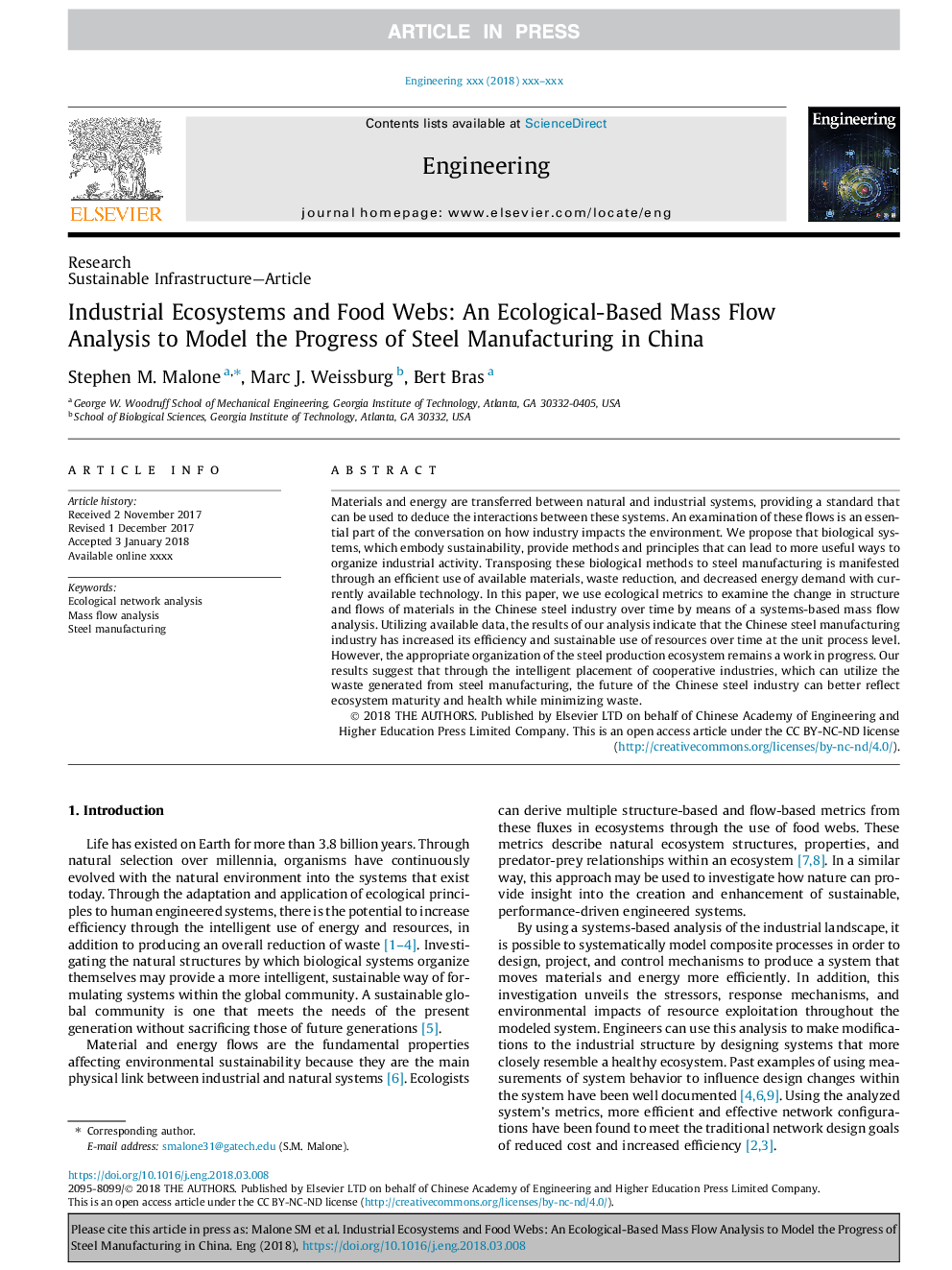| کد مقاله | کد نشریه | سال انتشار | مقاله انگلیسی | نسخه تمام متن |
|---|---|---|---|---|
| 6893308 | 1445559 | 2018 | 9 صفحه PDF | دانلود رایگان |
عنوان انگلیسی مقاله ISI
Industrial Ecosystems and Food Webs: An Ecological-Based Mass Flow Analysis to Model the Progress of Steel Manufacturing in China
ترجمه فارسی عنوان
اکوسیستم های صنعتی و شبکه های غذایی: تجزیه و تحلیل جریان جرمی مبتنی بر اکولوژیک برای مدل سازی پیشرفت تولید فولاد در چین
دانلود مقاله + سفارش ترجمه
دانلود مقاله ISI انگلیسی
رایگان برای ایرانیان
کلمات کلیدی
تجزیه و تحلیل شبکه محیط زیست، تحلیل جریان جرمی، تولید فولاد،
ترجمه چکیده
مواد و انرژی بین سیستم های طبیعی و صنعتی منتقل می شود، و استانداردی را فراهم می کند که می تواند برای تعامل بین این سیستم ها استفاده شود. بررسی این جریان بخش مهمی از گفتگو درباره چگونگی تاثیرگذاری بر محیط زیست است. ما پیشنهاد می کنیم که سیستم های بیولوژیکی، که ماندگار بودن آن، ارائه روش ها و اصول است که می تواند منجر به راه های مفید تر برای سازماندهی فعالیت های صنعتی است. انتقال این روش های بیولوژیکی به تولید فولاد از طریق استفاده موثر از مواد موجود، کاهش ضایعات و کاهش تقاضای انرژی با تکنولوژی در حال حاضر در دسترس است. در این مقاله، از معیارهای اکولوژیکی برای بررسی تغییر ساختار و جریان مواد در صنعت فولاد چینی در طول زمان با استفاده از تحلیل جریان جرم بر پایه سیستم استفاده می شود. با استفاده از داده های موجود، نتایج تجزیه و تحلیل ما نشان می دهد که صنعت تولید فولاد چین، بهره وری و استفاده پایدار از منابع در طول زمان در سطح فرآیند واحد افزایش یافته است. با این حال، سازماندهی مناسب اکوسیستم تولید فولاد همچنان یک کار در حال پیشرفت است. نتایج ما نشان می دهد که از طریق قرار دادن هوشمند صنایع تعاونی، که می تواند از زباله های تولید شده از فولاد استفاده کند، آینده صنایع فولاد چینی، می تواند بهتر از بلوغ اکوسیستم و سلامت در حالی که به حداقل رساندن زباله ها منعکس می شود.
موضوعات مرتبط
مهندسی و علوم پایه
مهندسی کامپیوتر
علوم کامپیوتر (عمومی)
چکیده انگلیسی
Materials and energy are transferred between natural and industrial systems, providing a standard that can be used to deduce the interactions between these systems. An examination of these flows is an essential part of the conversation on how industry impacts the environment. We propose that biological systems, which embody sustainability, provide methods and principles that can lead to more useful ways to organize industrial activity. Transposing these biological methods to steel manufacturing is manifested through an efficient use of available materials, waste reduction, and decreased energy demand with currently available technology. In this paper, we use ecological metrics to examine the change in structure and flows of materials in the Chinese steel industry over time by means of a systems-based mass flow analysis. Utilizing available data, the results of our analysis indicate that the Chinese steel manufacturing industry has increased its efficiency and sustainable use of resources over time at the unit process level. However, the appropriate organization of the steel production ecosystem remains a work in progress. Our results suggest that through the intelligent placement of cooperative industries, which can utilize the waste generated from steel manufacturing, the future of the Chinese steel industry can better reflect ecosystem maturity and health while minimizing waste.
ناشر
Database: Elsevier - ScienceDirect (ساینس دایرکت)
Journal: Engineering - Volume 4, Issue 2, April 2018, Pages 209-217
Journal: Engineering - Volume 4, Issue 2, April 2018, Pages 209-217
نویسندگان
Stephen M. Malone, Marc J. Weissburg, Bert Bras,
